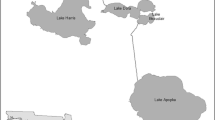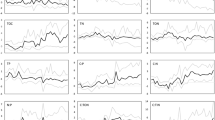Abstract
Research suggests the problems of nutrient over-enrichment (eutrophication) and climatic warming are coalescing in lakes globally. This oftentimes leads to cyanobacteria dominance of lake algal communities, which is problematic because cyanobacteria can produce toxins, degrade beneficial and aesthetic properties of lake water, and impede fisheries production. Cyanobacteria are prevalent when lakes have high nutrients (especially phosphorus) and high water temperatures. Currently, industrialized animal production is a locally important source of excess nutrients. Various means have been employed to alleviate the negative consequences of eutrophication and cyanobacteria blooms, with controls on external nutrient inputs being the most effective. More aggressive nutrient control programs will be called for in the future just to hold pace with the steadily declining water quality in many lakes.
Access this chapter
Tax calculation will be finalised at checkout
Purchases are for personal use only
Similar content being viewed by others
References
Adrian R et al (2009) Lakes as sentinels of climate change. Limnol Oceanogr 54:2283–2297
Arts MT, Ackman RG, Holub BJ (2001) “Essential fatty acids” in aquatic ecosystems: a crucial link between diet and human health and evolution. Can J Fish Aquat Sci 58:122–137
Brett MT, Benjamin MM (2008) A reassessment of lake phosphorus retention and the nutrient loading concept in limnology. Freshwater Biol 53:194–211
Cooke GD, Welch EB, Peterson SA, Nichols (2005) Restoration and management of lakes and reservoirs, 3rd edn. Taylor & Francis, Boca Raton
Edmondson WT (1972) Nutrients and phytoplankton in Lake Washington. American society of limnology and oceanography special symposium, vol 1, pp 172–188
Jones JR, Obrecht DV, Thorpe AP (2011) Chlorophyll maxima and chlorophyll: total phosphorus ratios in Missouri reservoirs. Lake Reserv Manage 27:321–328
Moss B et al (2011) Allied attack: climate change and eutrophication. Inland Waters 1:101–105
Nürnberg G (1996) Trophic state of clear and colored, soft- and hardwater lakes with special consideration of nutrients, anoxia, phytoplankton and fish. Lake Reserv Manage 12:432–447
Schindler DW, Vallentyne JR (2008) The algal bowl. Over-fertilization of the world’s freshwaters and estuaries. The University of Alberta Press, Edmonton
Smith VH, Schindler DW (2009) Eutrophication science: where do we go from here? Trends Ecol Evol 24:201–207
Author information
Authors and Affiliations
Corresponding author
Editor information
Editors and Affiliations
Rights and permissions
Copyright information
© 2014 Springer Science+Business Media Dordrecht
About this entry
Cite this entry
Jones, J., Brett, M.T. (2014). Lake Nutrients, Eutrophication, and Climate Change. In: Freedman, B. (eds) Global Environmental Change. Handbook of Global Environmental Pollution, vol 1. Springer, Dordrecht. https://doi.org/10.1007/978-94-007-5784-4_109
Download citation
DOI: https://doi.org/10.1007/978-94-007-5784-4_109
Published:
Publisher Name: Springer, Dordrecht
Print ISBN: 978-94-007-5783-7
Online ISBN: 978-94-007-5784-4
eBook Packages: Earth and Environmental ScienceReference Module Physical and Materials ScienceReference Module Earth and Environmental Sciences




